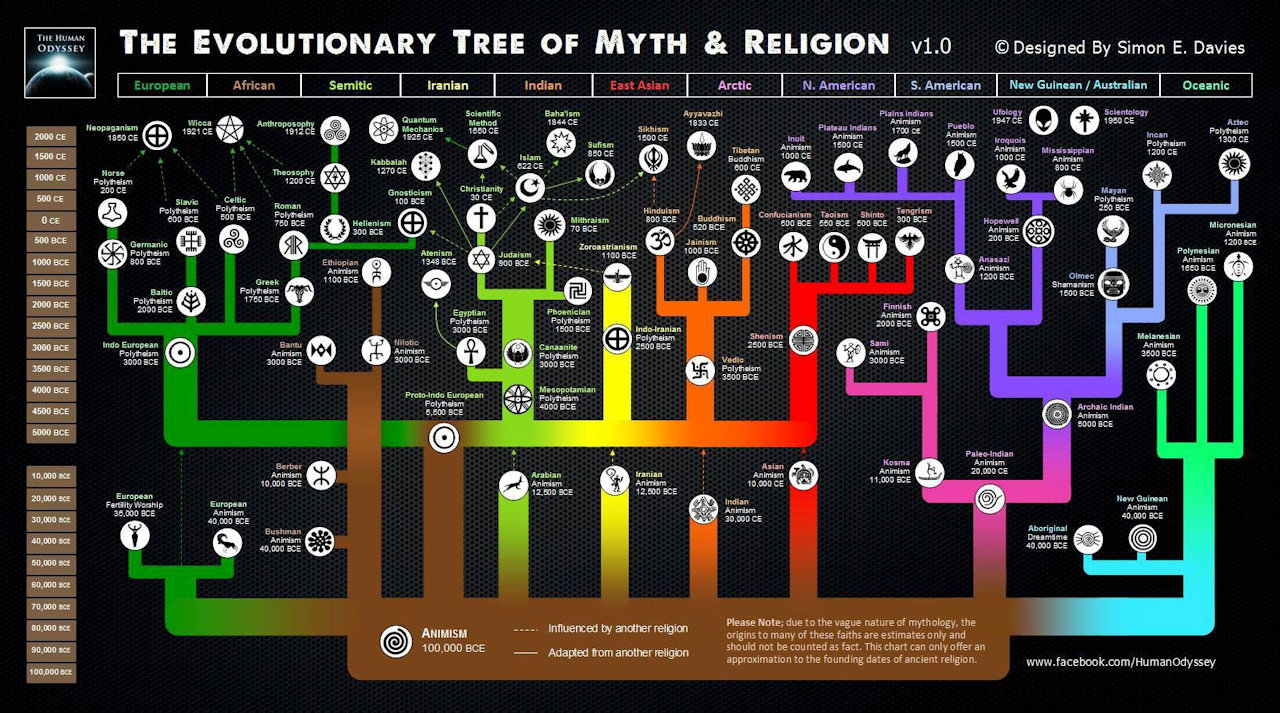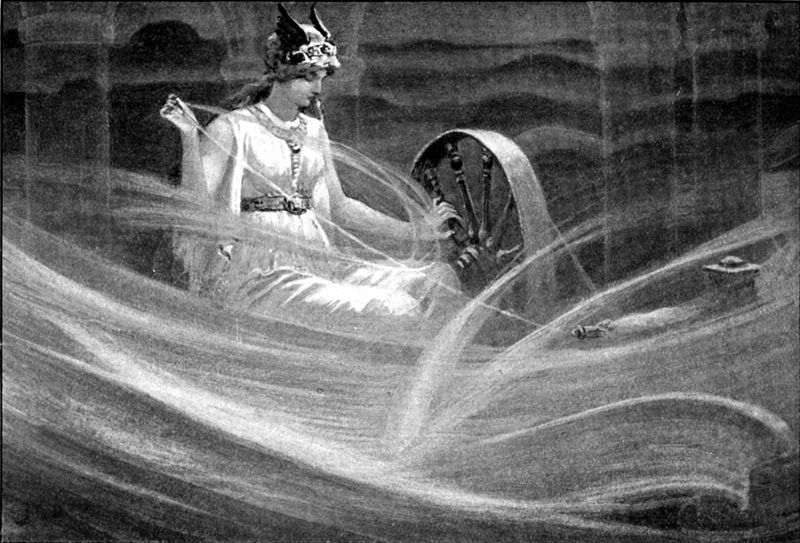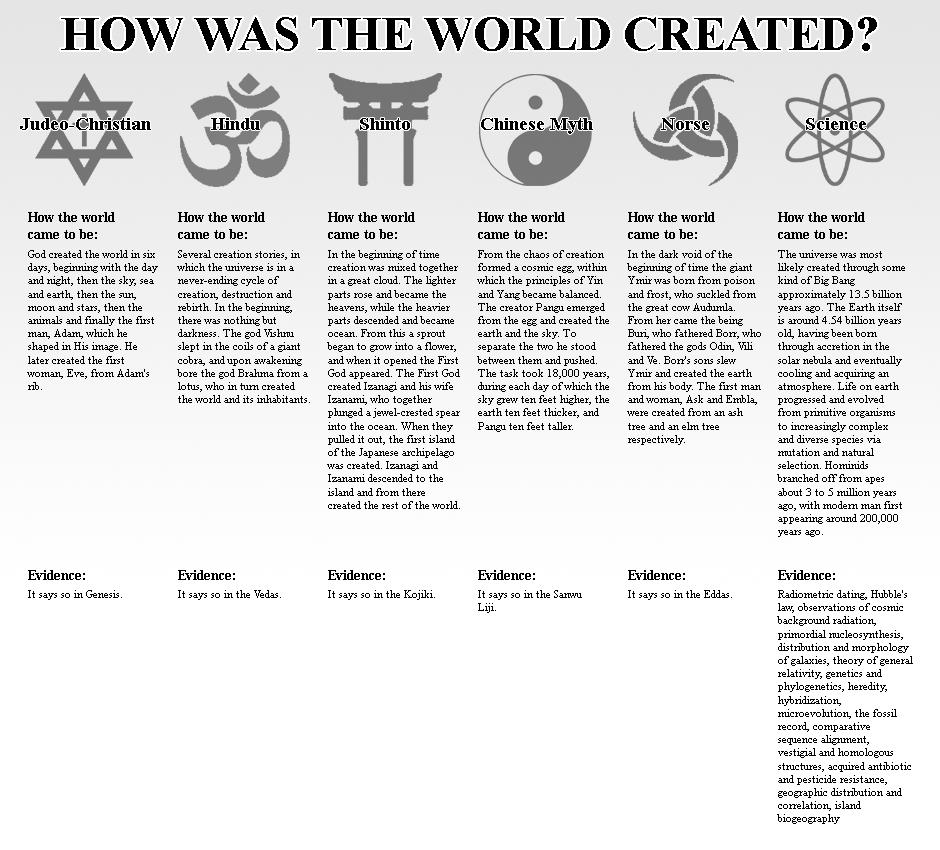Theology
All the world’s major religions, with their emphasis on love, compassion, patience, tolerance, and forgiveness can and do
promote inner values. But the reality of the world today is that grounding ethics in religion is no longer adequate. This
is why I am increasingly convinced that the time has come to find a way of thinking about spirituality and ethics beyond
religion altogether. --Dalai Lama
I have heard it said that theology is a science without a subject, but as the list below shows, gods are actually abundant.
In fact, there are over four million gods in the Hawaiian pantheon alone! (Ku Kanaka, George Kanahele, Univeristy of Hawaii
Press, 1986)
The Evolutionary Tree of Myth and Religion

The evolutionary tree of myth and religion. Click the image to see the full resolution version.
God of the Week
This is week
Many of the descriptions below are abstracted from Wikipedia.
- Ahura Mazda: Ancient Iranian god of light and wisdom.
- Anubis: Jackal-headed god associated with mummification and the afterlife
in ancient Egyptian religion. He is the son of Nephthys and Set according to the Egyptian mythology.
- Aphrodite: Greek goddess of love, beauty, sexuality, pleasure, and
procreation. Her Roman equivalent is the goddess Venus.
- Apollo: Apollo has been variously recognized as a god of light and
the sun, truth and prophecy, healing, plague, music, poetry, and more. Apollo is the son of Zeus and Leto, and has a twin sister,
the chaste huntress Artemis.
- Artemis: Artemis was one of the most widely venerated of the ancient
Greek deities. Her Roman equivalent is Diana. Artemis often described as the daughter of Zeus and Leto, and the twin sister
of Apollo. She was the Hellenic goddess of the hunt, wild animals, wilderness, childbirth, virginity, and protector of young girls,
bringing and relieving disease in women; she often was depicted as a huntress carrying a bow and arrows. The deer and the cypress
were sacred to her.
- Atë: Greek goddess of mischief, delusion, and folly.
- Athena: goddess of wisdom, courage, inspiration, civilization,
law and justice, just warfare, mathematics, strength, strategy, the arts, crafts, and skill. Minerva, Athena's Roman incarnation,
embodies similar attributes.
- Brahma: the Hindu god (deva) of creation and one of the Trimurti, the others
being Vishnu and Siva. According to the Brahma Purana, he is the father of Manu, and from Manu all human beings are descended.
- Cronus: Cronus was the leader and the youngest of the first generation
of Titans, divine descendants of Gaia, the earth, and Uranus, the sky. He overthrew his father and ruled during the mythological
Golden Age, until he was overthrown by his own son, Zeus and imprisoned in Tartarus.
- Demiurge: The demiurge is a concept from the Platonic, Neopythagorean,
Middle Platonic, and Neoplatonic schools of philosophy for an artisan-like figure responsible for the fashioning and maintenance
of the physical universe. The term was subsequently adopted by the Gnostics. Although a fashioner, the demiurge is not necessarily
thought of as being the same as the creator figure in the familiar monotheistic sense, because both the demiurge
itself plus the material from which the demiurge fashions the universe are considered either uncreated and eternal, or the product
of some other being, depending on the system.
- El: In the Canaanite religion, or Levantine religion as a whole, El or
Il was the supreme god, the father of humankind and all creatures and the husband of the goddess Asherah as recorded in the clay
tablets of Ugarit.
- Enki: a god in Sumerian mythology, later known as Ea in Akkadian and
Babylonian mythology. He was originally patron god of the city of Eridu, but later the influence of his cult spread throughout
Mesopotamia and to the Canaanites, Hittites and Hurrians. He was the deity of crafts, mischief, water, seawater, lakewater,
intelligence, and creation.
- Eris: Greek goddess of chaos, strife and discord.
- Freyja: In Norse mythology, Freyja is a goddess associated with love,
beauty, fertility, gold, seiðr, war, and death. Freyja is the owner of the necklace Brísingamen, rides a chariot pulled by two
cats, owns the boar Hildisvíni, possesses a cloak of falcon feathers, and, by her husband Óðr, is the mother of two daughters,
Hnoss and Gersemi.
- Frigg: Frigg (sometimes anglicized as Frigga) is a major goddess in
Norse paganism, a subset of Germanic paganism. She is said to be the wife of Odin, and is the "foremost among the goddesses"
and the queen of Asgard. Frigg appears primarily in Norse mythological stories as a wife and a mother. She is also described
as having the power of prophecy yet she does not reveal what she knows. Frigg is described as the only one other than Odin who
is permitted to sit on his high seat Hlidskjalf and look out over the universe. The English term Friday derives from the
Anglo-Saxon name for Frigg, Frige.
- Fujin: Japanese god of the wind and one of the eldest Shinto gods.
He is portrayed as a terrifying dark demon, resembling a red headed black humanoid wearing a leopard skin, carrying a large bag
of winds on his shoulders. In Japanese art, the deity is often depicted together with Raijin, the god of lightning, thunder and
storms.
- Ganesha: One of the deities best-known and most widely
worshipped in the Hindu pantheon. His image is found throughout India and Nepal. Hindu sects worship him regardless
of affiliations. Devotion to Ganesha is widely diffused and extends to Jains, Buddhists, and beyond India. Although he is
known by many other attributes, Ganesha's elephant head makes him particularly easy to identify. Ganesha is widely revered
as the Remover of Obstacles and more generally as Lord of Beginnings and Lord of Obstacles, patron of arts and sciences,
and the deva of intellect and wisdom.
- Hachiman: Also known as Hachiman-shin or Yawata no Kami, he is the
god of war and the divine protector of Japan and its people. Originally an agricultural deity, he later became the guardian
of the Minamoto clan. His symbolic animal and messenger is the dove.
- Horus: Horus is one of the oldest and most significant deities in
ancient Egyptian religion, who was worshipped from at least the late Predynastic period through to Greco-Roman times.
The son of Isis and Osiris, he was most often depicted as a falcon, most likely a lanner or peregrine, or as a man with a
falcon head.
- Ishtar: the Assyrian and Babylonian goddess of fertility, war, love,
and sex. She is the counterpart to the Sumerian Inanna and to the cognate north-west Semitic goddess Astarte.
- Isis: A goddess in Ancient Egyptian religious beliefs
whose worship spread throughout the Greco-Roman world. She was worshipped as the ideal mother and wife as well as the
patron of nature and magic.
- Janus: In ancient Roman religion and mythology, Janus (Latin: Ianus)
is the god of beginnings and transitions, thence also of gates, doors, doorways, endings and time. He is usually a
two-faced god since he looks to the future and the past. The Romans dedicated the month of January to Janus.
- Kane: Hawaiian creator god, associated with light and sky. Ku,
Kane, and Lono caused light to shine in upon the world. They are uncreated gods who have existed from eternity. Rituals for
Ku included human sacrifice, which was not part of the worship of the other gods.
- Krishna: Hindu deity, a "complete" avatar (or "incarnation") of
the preserver-god, Vishnu. Krishna is often described and portrayed as an infant or young boy playing a flute as in the
Bhagavata Purana, or as a youthful prince giving direction and guidance as in the Bhagavad Gita. The stories of Krishna
appear across a broad spectrum of Hindu philosophical and theological traditions. They portray him in various perspectives:
a god-child, a prankster, a model lover, a divine hero and the Supreme Being.
- Ku: Hawaiian god of war and the husband of the goddess Hina.
- Lono: Lono is associated with fertility, agriculture, rainfall, and
music. In one of the many Hawaiian legends of Lono, he is a fertility and music god who descended to Earth on a rainbow to marry
Laka. In agricultural and planting traditions, Lono was identified with rain and food plants. He was one of the four gods
(with Ku, Kane, and Kane's twin brother Kanaloa) who existed before the world was created. Lono was also the god of peace.
In his honor, the great annual festival of the Makahiki was held. During this period (from October through February), war
and unnecessary work was kapu (forbidden). In Hawaiian weather terminology, the winter Kona storms that bring rain to leeward
areas are associated with Lono. Lono brings on the rains and dispenses fertility.
- Loki: In Norse mythology, Loki or Loptr is a god or jötunn (or both).
Loki is the son of Fárbauti and Laufey, and the brother of Helblindi and Býleistr. By the jötunn Angrboða, Loki is the father
of Hel, the wolf Fenrir, and the world serpent Jörmungandr. By his wife Sigyn, Loki is the father of Nari or Narfi. And by the
stallion Svaðilfari, Loki is the mother—giving birth in the form of a mare—to the eight-legged horse Sleipnir. In addition,
Loki is referred to as the father of Váli in the Prose Edda. Loki's relation with the gods varies by source. Loki sometimes
assists the gods and sometimes causes problems for them. Loki is a shape shifter and in separate incidents he appears in the
form of a salmon, mare, seal, a fly, and possibly an elderly woman.
- Morpheus: In Greek mythology, Morpheus is the god of
dreams, leader of the Oneiroi. Morpheus has the ability to take any human form and appear in dreams. His true semblance is
that of a winged daemon, imagery shared with many of his siblings.
- Nikkal: Canaan goddess of orchards, is daughter of Khirkhibi, the
Summer's King, and is married to the moon god Yarikh.
- Nut: Goddess of the sky in the Ennead of Egyptian mythology. She
was seen as a star-covered nude human arching over the earth.
- Ometeotl: Ometeotl (Two God) is a name sometimes used about the pair
of god Ometecuhtli/Omecihuatl (also known as Tonacatecuhtli and Tonacacihuatl) in Aztec mythology. Whether such a deity existed
among the Aztecs and what its meaning was, is a matter of dispute among scholars of Mesoamerican religion.
- Omoikane: The Shinto deity of wisdom and intelligence, who
is always called upon to "ponder" and give good counsel in the deliberations of the heavenly deities.
- Osiris: Egyptian god, usually identified as the god of the afterlife,
the underworld and the dead. He was classically depicted as a green-skinned man with a pharaoh's beard, partially mummy-wrapped
at the legs, wearing a distinctive crown with two large ostrich feathers at either side, and holding a symbolic crook and flail.
- Pele: In the Hawaiian religion, Pele is the goddess of fire,
lightning, wind, and volcanoes. She is a popular figure in many stories of ancient Hawaii.
- Qebui: Egyptian god of the North Wind. He is a male and in art, Qebui
appears as a man with four ram heads, or a winged, four-headed ram.
- Quetzalcoatl: Feathered serpent deity in the Aztec religion.
Quetzalcoatl was related to gods of the wind, of Venus, of the dawn, of merchants and of arts, crafts and knowledge. He was
also the patron god of the Aztec priesthood, of learning and knowledge.
- Raijin: Raijin is a god of lightning, thunder, and storms in the Shinto
religion and in Japanese mythology.
- Rama: Rama or Ramachandra is the seventh avatar of the god Vishnu in
Hinduism, and a king of Ayodhya in Hindu scriptures. In a few Rama-centric sects, Rama is considered the Supreme Being, rather
than an avatar.
- Saturn: In ancient Roman religion and myth, Saturn
(Latin: Saturnus) was a god of agriculture, liberation, and time. His reign was depicted as a Golden Age of abundance
and peace. He was thus a god of wealth, and the Temple of Saturn in the Roman Forum housed the state treasury. In December,
he was celebrated at what is perhaps the most famous of the Roman festivals, the Saturnalia, a time of feasting, role
reversals, free speech, gift-giving and revelry. Saturn the planet and Saturday are both named after the god.
- Shiva: major Hindu deity, and is the Destroyer or Transformer among
the Trimurti, the Hindu Trinity of the primary aspects of the divine. He is regarded as the most powerful god in Hinduism.
In the Shaiva tradition of Hinduism, Shiva is the Supreme God and has five important works: creator, preserver, destroyer,
concealer, and revealer (to bless). In the Smarta tradition, he is regarded as one of the five primary forms of God. Followers
of Hinduism who focus their worship upon Shiva are called Shaivites or Shaivas (Sanskrit Saiva), one of the three most
influential denominations in Hinduism.
- Set: Set (also spelled Setesh, Sutekh, Setekh, or Suty)
is a god of the desert, storms, and foreigners in ancient Egyptian religion. In later myths he is also the god of darkness,
and chaos. In Ancient Greek, the god's name is given as Seth. In Egyptian mythology, Set is portrayed as the usurper
that killed and mutilated his own brother Osiris. Osiris' wife Isis reassembled Osiris' corpse and embalmed him. Osiris'
son Horus sought revenge upon Set, and the myths describe their conflicts. The death of Osiris and the battle between Horus
and Set is a popular theme in Egyptian mythology.
- Sophia: Goddess of wisdom. Sophia is the lowest Aeon,
or anthropic expression of the emanation of the light of God. She is considered to have fallen from grace in some way,
in so doing creating or helping to create the material world.
- Tammuz: Sumerian god of food and vegetation.
- Tezcatlipoca: Tezcatlipoca is a central deity in Aztec religion.
One of the four sons of Ometeotl, he is associated with a wide range of concepts, including the night sky, the night winds,
hurricanes, the north, the earth, obsidian, enmity, discord, rulership, divination, temptation, jaguars, sorcery, beauty, war
and strife.
- Thoth: Ancient Egyptian ibis headed god of knowledge and wisdom.
- Unut: Ancient Egyptian snake goddess.
- Vishnu: Supreme god in Hinduism, the preserver of the universe.
- Woden: A major deity in Germanic mythology.
- Xolotl: Aztec god associated with lightning and death.
- Yahweh: "... the god of Israel in the Hebrew Bible. Yahweh is a modern
scholarly vocalization of the name as it appears in Hebrew ..." --Wikipedia
- Yarikh: Yarikh, in Canaanite mythology, is a moon god whose epithets
are illuminator of the heavens, illuminator of the myriads of stars, and lord of the sickle. The latter epithet may come
from the appearance of the crescent moon. Yarikh was recognized as the provider of nightly dew, and married to the goddess
Nikkal, his moisture causing her orchards to bloom in the desert. The city of Jericho bears his name.
- Zeus: Top god in the ancient Greek pantheon. Stands for keeping one's
word. Symbols include the oak tree and the eagle. Equivalent to Jupiter (corruption of Zeus Pater, father Zeus, in Latin) in
the Roman pantheon.
If your favorite god is not yet listed here, please send me an email request with a brief description and I will include it
if feasible.

"Frigga Spinning the Clouds" by J. C. Dollman
FAQ
Frequently asked questions. If you don't have any questions, please skip to the next section.
- Q: How many gods are there?
A: The number of supernatural or theistic gods is zero. The number of internal (or natural) gods is equal to the number of beings who
are acquainted with (and recognize) their own inner divinity.
- Q: Is there life after death?
A: No. This is the only life you get. Make the most of it. If you haven't been doing that, i.e., treating everyone's life as an amazing,
priceless, and finite gift, it may not be too late to begin.
- Q: But what about reincarnation and people who remember past lives?
A: The unconscious mind can be a wonderful creative assistant or an unscrupulous trickster. You decide which.
- Q: Do you have any good news?
A: Yes, but not the kind that an egotist will find comforting. Buddha was wrong about reincarnation--that was the conventional wisdom
of his time. However, Buddha was right that the self or ego is an illusion. Hence, owing to the nature of identity and the
universal substrate of consciousness, as long as other people are alive, one's self is alive. The only thing that can truly kill us
is the extinction of life in general. This has the ethical implication that it behooves one to work toward maintenance and
nurturing of life everywhere, and toward expanding the range of life into the rest of the universe.
RAQ
Rarely asked questions.
- Q: Why are you silent on Islam?
A: I am under duress. Some adherents have been known to do hurtful things to some who remark about that religion.
- Q: Is Islam the only relgion for which this duress condition applies?
A: Yes, as far as I know.

Creation myths.TICQ
Tongue in cheek questions from Curtis Nichouls, via Facebook's "Being Liberal" page:
On her radio show, Dr. Laura said that, as an observant Orthodox Jew, homosexuality is an abomination according to Leviticus 18:22,
and cannot be condoned under any circumstance. The following response is an open letter to Dr. Schlesinger, written by a US man,
and posted on the Internet. It's funny, as well as quite informative:
Dear Dr. Laura:
Thank you for doing so much to educate people regarding God's Law. I have learned a great deal from your show, and try to share
that knowledge with as many people as I can. When someone tries to defend the homosexual lifestyle, for example, I simply remind
them that Leviticus 18:22 clearly states it to be an abomination. End of debate. I do need some advice from you, however, regarding
some other elements of God's Laws and how to follow them.
- Leviticus 25:44 states that I may possess slaves, both male and female, provided they are purchased from neighboring nations.
A friend of mine claims that this applies to Mexicans, but not Canadians. Can you clarify? Why can't I own Canadians?
- I would like to sell my daughter into slavery, as sanctioned in Exodus 21:7. In this day and age, what do you think would be
a fair price for her?
- I know that I am allowed no contact with a woman while she is in her period of menstrual uncleanliness - Lev.15: 19-24. The
problem is, how do I tell? I have tried asking, but most women take offense.
- When I burn a bull on the altar as a sacrifice, I know it creates a pleasing odor for the Lord - Lev.1:9. The problem is my
neighbors. They claim the odor is not pleasing to them. Should I smite them?
- I have a neighbor who insists on working on the Sabbath. Exodus 35:2 clearly states he should be put to death. Am I morally
obligated to kill him myself, or should I ask the police to do it?
- A friend of mine feels that even though eating shellfish is an abomination, Lev. 11:10, it is a lesser abomination than
homosexuality. I don't agree. Can you settle this? Are there 'degrees' of abomination?
- Lev. 21:20 states that I may not approach the altar of God if I have a defect in my sight. I have to admit that I wear reading
glasses. Does my vision have to be 20/20, or is there some wiggle-room here?
- Most of my male friends get their hair trimmed, including the hair around their temples, even though this is expressly forbidden
by Lev. 19:27. How should they die?
- I know from Lev. 11:6-8 that touching the skin of a dead pig makes me unclean, but may I still play football if I wear gloves?
- My uncle has a farm. He violates Lev.19:19 by planting two different crops in the same field, as does his wife by wearing
garments made of two different kinds of thread (cotton/polyester blend). He also tends to curse and blaspheme a lot. Is it really
necessary that we go to all the trouble of getting the whole town together to stone them? Lev.24:10-16. Couldn't we just burn them
to death at a private family affair, like we do with people who sleep with their in-laws? (Lev. 20:14)
I know you have studied these things extensively and thus enjoy considerable expertise in such matters, so I'm confident you can help.
Thank you again for reminding us that God's word is eternal and unchanging.
P.S. (It would be a damn shame if we couldn't own a Canadian.)

 Email Richard dot J dot Wagner at gmail dot com
Email Richard dot J dot Wagner at gmail dot com
index.html, this hand crafted HTML file created June 19, 2012.
Last updated June 7, 2021, by
Rick Wagner. Copyright © 2012-2021, all rights reserved.





 Email Richard dot J dot Wagner at gmail dot com
Email Richard dot J dot Wagner at gmail dot com